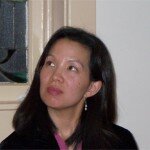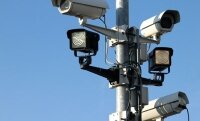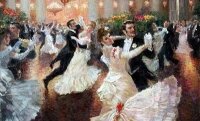Adrienne Su is the author of Middle Kingdom (Alice James Books, 1997), Sanctuary (Manic D Press, 2006), and the forthcoming Having None of It (Manic D Press, 2009), the latter of which formed the basis for this interview conducted via e-mail. She has held residencies at Yaddo, MacDowell, and the Fine Arts Work Center in Provincetown. Recipient of a 2007 National Endowment for the Arts literature fellowship, Adrienne is poet-in-residence at Dickinson College in Carlisle, Pennsylvania. Recent poems appear in Crazyhorse, Prairie Schooner, Green Mountains Review, and Southwest Review.
§
Many of the poems in your new book could be thought of as autobiographical. How do you decide how much of yourself to reflect in the writing and how much will be poetic license or persona?
When writing and revising, I aim to make something both sympathetic and believable, something that can reflect a recognizable truth to a reader. And—this might stem from my early years in poetry slams, which in their best incarnations create intense, often joyful connections between poets and audiences—I think of my reader as someone who may or may not have a literary background. Life, not literature or poetics, becomes the central common ground. Yet when poetic devices such as rhyme, meter, and form are doing their work, a reader can enjoy the effects regardless of whether he/she is equipped to explain why. It’s like enjoying a piece of music without being a musician, composer, or musicologist. And, depending on how it’s done, a poem can still make literary references without making the general reader feel excluded. Still, perhaps because most of us want what we don’t have, I’ve tried to write in ways that seem less autobiographical, but keep coming back to poems that have some link to real life. On the other hand, few of my poems are factually accurate. As a fellow poet, you already know this: the successful poem illustrates a human truth, rather than the precise details of an individual person’s life; a poem is an act of imagination that has to seem true for the duration. Many of the poems in Having None of It are about things I never experienced, such as the day-to-day lives of Chinese immigrants in Georgia in the 1950s and ’60s, and some of the poems take a male point of view. But of course, I wouldn’t have written these particular poems if I hadn’t been a woman, a mother, a single mother, a mother with a career, a Southerner, a Chinese American, a child of immigrants.
I wouldn’t have known from the poems that you’d participated in poetry slams, and think it’s important you’ve noted the connection between the poet and the audience. When did you begin writing more for the printed page? Do you see differences in these mediums?
Actually, in the beginning I thought I was always writing for the printed page. Before I fell into the slam circuit, my experience was mostly of the university type: workshops at Harvard, readings in Cambridge. High-school Latin had taught me the essence of what I knew about poetic form. I thought of poetry as a solitary art and didn’t know what a slam was. After college, living in New York, I dropped in at the Nuyorican Poets Café with a handful of poems, one or two of which I thought I might read in the open, not the slam. As it turned out, the slam was short one contestant, so the incomparable Bob Holman, who emceed, asked me to fill the gap. It snowballed from there. Overnight I discovered that you didn’t have to write “slam poetry” to connect with a non-university audience; you could trust the reader/listener to know and remember more than you thought. I was never the prototypical slam poet–not an actor, not a poet who reads from memory–but those were the early days of the slam revival (1990, 1991), when the form had more spontaneity and less polish. The competition wasn’t meant to be taken seriously; the prize for winning at the Nuyorican was your $3 cover back. Still, in 1991, Gavin Moses, Willie Perdomo, and I ended up going to the nationals as the New York City team. We paid our own airfare to Chicago, where local poets let us sleep on their couches. Bob coached us. One day, as the audience grew and the competition intensified, Bob said to me, “You’re a risk, you know.” He didn’t have to explain. I was clearly a “page poet.” For the most part, the New Yorkers hadn’t been bothered by that. At the national level, it was more of a gamble.
“…the successful poem illustrates
a human truth…”
I do think the mediums are different, especially as spoken word has become better known. The slam is more sophisticated now, and the inevitable tension has arisen between “slam” and “page.” And I don’t do slams anymore— in part because I haven’t lived in a city in years, in part because I was never exactly matched to it. But the experience has fundamentally affected the way I write and give readings, because I’ve never forgotten the magic of connecting with people radically different from myself through the spoken word—theirs or mine—and the importance of respecting one’s audience. It taught me that writing is social, if you publish or perform it. The Nuyorican was founded in the 1970s as a performance space for Puerto Ricans of the Lower East Side. By 1990, many of the regulars were neither Puerto Rican nor from the neighborhood, but many were, and East 3rd St. between B and C was still off the beaten path. On Friday nights we frequently found common ground within the three-minute limit.
The Women and The Girls, a selection from Adrienne’s Work
What process do you use when you’re assembling a poetry collection?
I set out with a degree of intention—a sense of what themes it should have and a consciousness of how the poems ought to work together—but remain open to surprises, as Robert Frost so famously instructed.
That is a wonderful way of describing the balance writers need between having a plan and remaining flexible—a book often goes through many transformations before it reaches its final form. Are you searching for something particular? How do you decide the order of your poems?
I still find organizing the poems to be one of the hardest things about putting together a book. I struggle with the desire to cultivate the sense of continuity you describe and the desire to shake things up—to have faith, as in the poetry slam, that the reader is going to connect the ideas and objects that the poet has deliberately placed far apart. There must be enough continuity to maintain the reader’s interest (as in a novel) but enough variety to keep providing the unexpected—without ever coming across as careless, arbitrary, or disdainful of the reader.
Usually I shuffle the poems around many times before they settle into a final order. The shuffling begins long before all of the poems have been written, and it goes a long way toward revealing specific gaps and helping to guide the process of finding—in the mind—the remaining poems. I’ve begun to imagine the book itself as a large form, perhaps comparable to a long poem in which the individual poems are operating as lines or stanzas.
Like you, I think about images that speak to one another from poem to poem. I look at the manuscript in different ways at different times, focusing on images or words that recur when I’m looking at the poems close up, and focusing on theme or tone when viewing the structure of the book as a skeleton, with each poem title on an index card spread out on a table. Both perspectives matter. There’s a lot to think about—and you have to ignore the fact that most readers aren’t going to read the book straight through, in order, but will jump around and maybe read a little today, a little next week or next month. In every way, writing and assembling a book of poems is fraught with doubt. Every poem changes when placed in the company of other poems. But that uncertainty makes the process interesting, a journey of discovery.
The title Having None of It echoes the final lines in the poem “Having it All”, but also seems to have larger connotations—what does the title mean to you?
Having grown up surrounded by people for whom English was a second language, I realize that the title doesn’t evoke the idiom for everyone. That was the appeal. To a newcomer to English, “having none of it” simply means “having nothing.” To a native speaker, of course, both meanings are apparent: refusing to take whatever malice is being dished out, and having nothing. I feel that this is what happened to my generation: inspired by the women’s movement and education that strove to be gender-neutral, we grew up believing that women (and men) could finally “have it all”: a good marriage, two satisfying careers, and the joys of raising children, all at the same time and without major damage to the marriage, children, or either career.

Photo: Lynn Johnson
Women wouldn’t have to shelve their careers for children, and men wouldn’t have to shelve their relationships with their children for their careers. No one addressed the question of who would empty the dishwasher and start dinner while babies wailed, both parents were sleep-deprived and had been working all day, nobody could see the floor to clean it, bills went unpaid because they were crumpled at the bottom of the diaper bag, and the nearest extended family member was hundreds of miles away.
Luckily we aren’t going back to the days when women had few career options, but the current formula isn’t realistic, either. (I think it can work, but only with serious social reform: good-quality childcare that’s both available and affordable, flexible work schedules for men and women, more integration of family and professional life, a more realistic vision of the future for young people.) I think the question at the heart of the title is: Why didn’t anybody teach us what we were in for? Our society could be much stronger for it.
I like that you mention how the issue affects both parents—parenting isn’t only a women’s issue, which some may frame it as, and thinking like that could limit the audience for the work when in reality the book has a much broader appeal. When do you find time to write?
Recently, the NEA grant has made all the difference in the world—the daily difference between writing and not writing— by lightening my teaching load for the two-year grant period. That’s not to say that teaching doesn’t give me a lot in return —it does, and my employer, Dickinson College, has been fabulously nurturing and supportive—but teaching does put the poet in the daily role of responsible leader, which is also true of parenting and the governance aspects of being a faculty member. So there’s no more staying up all night talking about nothing and everything with a bunch of other unemployed artists—at least, not often.
My creative work has to be done within considerable practical limits. I think it’s actually made me more effective than I was during the “bohemian” years of freelance writing, childlessness, frequent moves, and vast stretches of unscheduled time. I’ve learned to weave poetry writing in with the other requirements of life, even if it’s just ten minutes snatched here or there, and not to elevate it to a sacred activity that must be done in serenity and exile.
That’s probably one of the reasons I write about the ordinary, because it’s what’s available, but I did so when time was abundant, too, because I’ve long believed that the extraordinary most often resides within the ordinary (think of the fish in Mark Doty’s “A Display of Mackerel,” the butcher in Maxine Kumin’s “Taking the Lambs to Market,” the berries in Seamus Heaney’s “Blackberry-Picking,” Frost’s wooded landscapes, Bishop’s waiting room). And I look for ways to cultivate the mindfulness a poet needs even when there’s no time to write, through yoga, cooking, dog-walking, and—when possible—avoiding multitasking. That last one is a tall order. I have to work hard at being organized—doing non-poetic things like keeping a detailed calendar and cooking in quantity—because it’s the only way to clear space for imaginative freedom.
Reading and writing appear often: “the thread of ink that turns / into flesh as it travels”, “We’re the final book in a smoldering library” and in other poems, such as “Reading” or “Some Grandmothers”, bringing to mind everything from cultural revolution to the muse. Was there an inspiration?
If there was an inspiration, it’s the love of reading and writing. I didn’t set out to celebrate them exactly, but when I think about what’s important to me, both keep coming up. To me a good book is a world into which to travel—and it particularly fascinates me as a refuge for people whose lives are physically circumscribed. One of the many tragedies of the Chinese Cultural Revolution was the loss of education for so many young people, which always made me ask, What is it like to go through life not knowing the joy and transcendence of reading?
And I think of writing as a powerful act, worthy of, well, writing about. Maya Angelou writes movingly of her early discovery of the power of words in I Know Why the Caged Bird Sings, to decide matters of life and death. For me, writing is most often a means to understanding. When it goes well, it seems to anticipate what’s going to happen next in reality. I don’t think of it as magical but as a way to get in tune with life—as much an entry into it as an escape from it.
Which poems in the book are your favorites? Which were the most challenging to write?
I’ve never been good with choosing favorite anything, but if pressed, I’d probably pick “Middle of Nowhere,” “The Amazing Part,” “Animal Mornings,” and “Goddess / Sybil / Lactation Consultant.” Among the hardest to write: “1989” because I had too much information about the events that prompted it, “Imagining China” because it didn’t find its shape for years, and “Goddess / Sybil / Lactation Consultant” because it had several obsessions wrapped up in a slightly longer narrative than usual. I wasn’t sure it could contain everything. But writing a poem is never a sure thing. That’s the challenge, isn’t it? And the thrill.
The lines in the poem “Inheritance” (“Hardest to build / is sense of place, but once you’ve willed / away the past, you’ll find the soil soft, / each room yielding to the youngest blood / of history”) are an important theme in many of these poems, along with the theme of generational differences. What would you like readers to understand about this?
It’s about the experience of remaking oneself under a variety of circumstances, which is somewhere in the narrative of many American families but happens in many other parts of the world as well, especially as people continue to be displaced by war. I would hope that the heart of the issue is seen more as human than as specifically American or Chinese-American.
Has your work changed with this third book?
I’m not sure. I may be the wrong person to say. I’ve let go of form a little, in some poems, and used the second-and third-person points of view quite liberally.
This is your second book from Manic D Press. How did you first find the publisher? What has your experience been like?
Manic D has been wonderful. We found each other through the anthology Poetry Slam: The Competitive Art of Performance Poetry, edited by Gary Glazner. Jennifer Joseph, the founder and publisher, has a passion for poetry, a sense of the audience for unusual books, and a great sense of humor.
–
–
Karen Rigby is the former Poetry Editor for Emprise Review and currently edits Cerise Press.







